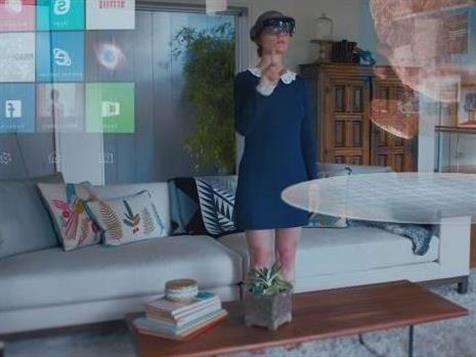Holographs are about to change our world

With the release of Microsoft HoloLens, holographs are emerging as the next evolution in computing offering new creative, as well as practical, opportunities.
For years we have sat in cinemas with a mild dose of disbelief as screen characters grab and chuck, shuffle and arrange information on virtual screens hovering in space, as if it happened everyday.
It seems that that is soon to be a reality. Holograms are being touted as the next evolution in computing.
Next week, Microsoft will unveil the new HoloLens, a headset with a see-through lens that merges digital content with the physical world. The company has been vague just when it’ll start selling HoloLens, but have stated that it will be ‘in the Windows 10 time frame.’
The arrival of this new technology has implications that are likely to change the way we perceive and interact with images. Artists are already experimenting with holograms but the wide availability of HoloLens will grow opportunities for creative exploration of this new way of seeing.
Meet Microsoft’s HoloLens; source YouTube
What is a hologram?
Holograms have been around since the late 1940s when Hungarian-born scientist Dennis Gabor developed the theory of holography while working to improve the resolution of an electron microscope. It was really in the 1960s that his discoveries took traction and by 1968 artists were starting to work with holograms as a medium.
Simply defined, holograms are encodings of light fields rather than of images that are formed by a lens.
Martina Mrongovius, Director of the New York-based Holocentre, explained: ‘A hologram is made by recording the shape of light. To do this we use laser light to illuminate the scene and a reference beam split off from the same laser to encode the light. With a photograph, light is focused onto the film; with a hologram the light is recorded as it passes through the ‘window’ of the film.’
Seth Riskin, MIT Museum’s Manager of Emerging Technologies and Holography/Spatial Imaging Initiatives (USA) expanded: ‘A hologram, represents how the human brain and light information interact to create the experience of three-dimensional space.’
The holographic recording itself is not an image. It consists of an apparently ‘random structure of varying intensity, density or surface profile. When it is suitably lit, the original light field is recreated and the view of the objects that used to be in it changes as the position and orientation of the viewer changes, as if the objects were still there.’
In its pure form, holography requires the use of laser light for illuminating the subject. Holograms now, however, can also be entirely computer-generated. Enter Microsoft HoloLens.

Holograms in Art
It is a timely conversation, especially in this year of light, to reconsider the past, potential and future of holograms. Currently at the National Gallery of Australia are two holograms on display by James Turrell made between 2006 and 2008. Unlike traditional holograms that depict objects, the Turrell holograms aim to make a hologram of light itself. He began making holograms in the 1980s and are closely related to his early projections.
Salvador Dali claimed to have been the first to employ holography artistically. He was certainly the first and best-known surrealist to do so, but the 1972 New York exhibit of Dalí holograms had been preceded by another. The first holographic art exhibition was held in 1968 at the Cranbook Academy of Art in Michigan followed by the one at the Finch College gallery in New York in 1970, which attracted national media attention.
Early on the holographic works of artists were recognised as collectable. The Museum of Holography, New York, was founded in 1976 as an international center for the understanding and advancement of this new medium. Soon following the San Francisco School of Holography, the Royal College of Art in London and the Lake Forest College Symposiums in Illinois (USA), organised by leading scholar in field since 1960s Tung Jeong (T.J.) created a swell around the medium. None of these exist today.

Sally Weber, Laccolith, 2006 Open Aperture Transmission Hologram; source The Center for the Holographic Arts.
Still thriving is the non-profit Center for the Holographic Arts (Holocenter) in New York (founded by the well known holographic artists Ana Maria Nicholson and Dan Schweitzer in 1998), The MIT Museum at the Massachusetts Institute of Technology (which acquired the complete holdings of the Museum of Holography in 1993 and remains the largest collection of holographs globally), The Jonathan Ross Hologram Collection (USA), the online Global Image Hologram Collection, the HOLOcenter in Seoul, and in September 2013 a new hologram centre opened in Long Island City, New York.
Holocenter Director, Martina Mrongovius said it wants to ensure holography continues to be a creative process. That no longer seems to be a question with the introduction of Microsoft’s HoloLens, which can only lead to a spin off of new programming and imaging.
These spaces present workshop and exhibition, noted was the international exhibition MIT Museum presented, The Jeweled Net: Views of Contemporary Holography that drew artists using holography from Germany, Italy, the UK, Canada, Australia, Japan, and the US.
Seth Riskin, MIT Museum’s Manager of Emerging Technologies and Holography/Spatial Imaging Initiatives, said the exhibition was an example of their commitment to support public engagement with practicing holographic artists.
‘Holography has given birth to a new field of science during the past six decades, and as well, to a group of “pioneers” who have found a new media upon which human vision in three dimensions is transferred,’ added Riskin.
Microsoft will take that to another level this year. No longer will the holograph just be a chip on our credit card, but they will have the capacity to alter how we view the work with the new HoloLens.
First published on ArtsHubt 24 April 2015.